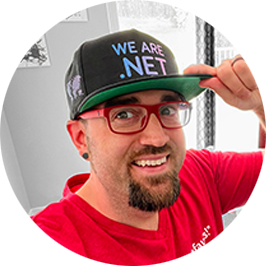Learn how to use Configuration and Options in any .NET codebase
Configuration is one of the core fundamentals of any .NET application. Whether it's a web application, an API, a desktop application or anything in between, every application has settings and options that make it configurable, flexible and functional. From simple numbers and booleans to connection strings that need to be stored and loaded securely, everything needs to be handled with care and a complete understanding of how they work and what is happening under the hood. In this course, Microsoft Senior Content Developer David Pine will teach you everything you need to know to get up to speed with Configuration and Options in .NET.
Curriculum
Welcome (01:14)
What will you learn in this course? (01:45)
Who is the course for and prerequisites (00:34)
Introduction (00:49)
What is Configuration? (01:45)
Why configuration is important? (01:38)
Configuration in .NET (01:28)
Configuration sources & providers (01:11)
First Configuration NuGet package (02:47)
Explore the IConfiguration and related APIs (07:34)
Section Recap (01:21)
Introduction (01:08)
Standalone vs. Host (04:04)
What’s a ConfigurationManager? (01:21)
Exploring the Worker Service default configuration (01:30)
Running the Worker Service with template behavior (00:34)
Learning the JSON configuration provider capabilities (01:45)
Environment specific configuration (02:56)
Configuring and manually parsing custom values (01:43)
Benefiting from the Binder package (01:41)
Section Recap (01:31)
Introduction to Configuration Providers (00:37)
Base File Providers (00:47)
Discussing the empty application builder sample app (01:13)
JSON configuration provider (03:00)
XML configuration provider (01:51)
INI configuration provider (01:48)
User Secrets configuration provider (01:36)
Managing user secrets (06:36)
Environment Variables configuration provider (02:31)
Command-line configuration provider (03:31)
Key-per file configuration provider (02:25)
Azure Key Vault configuration provider (04:10)
Azure App Configuration provider with Key Vault secrets (03:36)
Section Recap (00:59)
Introduction to Implementing a Custom Configuration Provider (01:31)
Create the implementation class library (01:35)
Implement the IConfigurationSource (01:23)
Implement the IConfigurationProvider (02:27)
Extend IConfigurationBuilder and expose AddYamlFile APIs (02:22)
Implementing the YAML parser (09:35)
Review and Finalize implementation details (02:11)
Consuming YAML configuration with custom provider (04:30)
Section Recap (01:07)
Introduction to the Options Pattern (02:09)
Modeling the Logging Options (02:09)
Bind Logging Options to Configuration (01:50)
Consuming Logging Options through DI (02:41)
Adding another options-modeled object (01:02)
Binding additional named-options (01:48)
Configuring and editing named-options (01:30)
Resolving named-options by name (01:30)
Verifying configuration bindings and DI hydration (01:13)
Considering alternative APIs for registering options (01:40)
Overriding configurations with post configure APIs (02:15)
Overriding all config-bound instances (01:52)
Avoid implementing IOptions<T> (01:58)
Understanding reflection-based binding (02:14)
Enabling source-generated configuration binding (02:05)
Section Recap (01:01)
Introduction to Validating Options (01:42)
Implementing the IValidateOptions<TOptions> interface (05:07)
Registering options with validation (03:03)
Using data-annotations for declarative validation (04:45)
Handling validation errors (04:36)
Expressing simple delegate-based validation with fluent APIs (03:21)
Controlling when validation errors occur (02:24)
Compile-time validation with source-generators (04:07)
Section Recap (01:36)
Introduction to Options Monitoring (01:14)
Differentiating Options interfaces (02:10)
Visualizing an Alerting App Scenario (01:07)
Exploring the Alerting Implementation (07:47)
Post Code-walk: Options and Settings (03:08)
Changing Config Data & Monitoring Alerts (02:04)
Being Mindful of Monitoring Limitations (01:32)
Section Recap (01:13)
Introduction to Consumer-Centric (Empathy-based) Authoring (00:53)
Defining Strongly-typed WidgetOptions (01:26)
Debating namespace Naming: IServiceCollection Extensions (01:11)
Exploring an Add* with IConfigurationSection API (01:55)
Consuming the Add* with IConfigurationSection (03:35)
Improving consumer experiences through meaningful error messages (01:35)
Confirming new consumer experiences (01:52)
Considerations when accepting Option-types as Add* API parameters (01:53)
Consuming the Add* with Options-type API (02:18)
Exposing an Action<WidgetOptions> API (01:43)
The Importance of Consistent APIs (01:58)
Using the configureOptions delegate-based API (02:29)
Section Recap (01:19)
Conclusion (01:23)
Course Info

Lifetime access
Add to CartAbout the Author

David Pine
David Pine works in Developer Relations at Microsoft, focusing on .NET and Azure developer content. He is recognized as a Google Developer Expert in Web Technologies. David is the O'Reilly Media author of "Learning Blazor: Build Single-Page Apps with WebAssembly and C#". David focuses on the developer community, actively seeking opportunities to share knowledge through speaking engagements around the world. David advocates for open-source, the .NET Foundation, C#, TypeScript, SignalR, Reactive Extensions, Azure and .NET. He's a co-host of the On .NET Live stream, part of the .NET Live TV family of streaming shows.
More courses by David Pine© 2025 Dometrain. All rights reserved.

